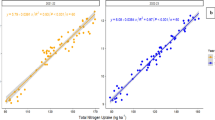Abstract
In the present study, an effort was made to calibrate and validate a crop model using the experiment generated data pertaining to growth and yield of wheat cultivars under irrigated saline environment using foliar potassium application. A field experiment was conducted at Water Technology Centre research farm, Indian Agricultural Research Institute, New Delhi, in split–split plot design during rabi 2011–2012 and 2012–2013 to generate data for simulation of FAO AquaCrop model. Two wheat cultivars (i.e. one salt tolerant KRL-1-4 and other salt susceptible HD 2894) under four salinity levels, viz, GW (1.7 dS m−1), 4, 8 and 12 dS m−1 were experimented under foliar and non-foliar treatments. AquaCrop model was calibrated using experiment data of rabi 2011–2012 and validated with data of rabi 2012–2013. The model evaluation parameters, viz, model efficiency (ME), index of agreement (d) and R2 pertaining to grain yield of both wheat cultivars predicted by validated model were averaged to be 0.86, 0.95 and 0.96, respectively, under all treatment levels. Moreover, the simulated biomass yield of both the cultivars was with average values of ME, d and R2 as 0.91, 0.97, and 0.93, respectively. However, model validation results for water productivity were 0.60, 0.82 and 0.93 for ME, d and R2, respectively. It was observed that the AquaCrop model simulation for grain yield was better as compared to biomass and water productivity for all treatment levels. Validated model resulted in predicted grain yield of both wheat cultivars with low prediction error (i.e. 1.77–6.52%) up to 8 dS m−1, whereas at 12 dS m−1 salinity level, the prediction error increased and varied from 21.7 to 37.5%. Nonetheless, the FAO AquaCrop model can be used with acceptable accuracy for simulation of grain yield of wheat cultivars using saline irrigation up to 8 dS m−1 with foliar potassium fertilization.














Similar content being viewed by others
References
Abedinpour M, Sarangi A, Rajput TBS, Singh M, Pathak H, Ahmad T (2012) Performance evaluation of AquaCrop model for maize crop in a semi-arid environment. Agric Water Manag 110:55–66
Andarzian B, Bannayan M, Steduto P, Mazraeh H, Barati ME, Barati MA, Rahnama A (2011) Validation and testing of the AquaCrop model under full and deficit irrigated wheat production in Iran. Agric Water Manag 100:1–8
Heng LK, Hsiao TC, Evett S, Howell T, Steduto P (2009) Validating the FAO AquaCrop model for irrigated and water deficient field maize. Agron J 101:488–498
Hsiao TC, Heng LK, Steduto P, Rojas-Lara B, Raes D, Fereres E (2009) AquaCrop-the FAO crop model to simulate yield response to water: III. Parameterization and testing for maize. Agron J 101:448–459
Kumar P, Sarangi A, Singh DK, Parihar SS (2014) Evaluation of AquaCrop model in predicting wheat yield and water productivity under irrigated saline regimes. Irrig Drain 63:474–487
Kumar M, Sarangi A, Singh DK, Rao AR, Sudhishri S (2016) Response of wheat cultivars to foliar potassium fertilization under irrigated saline environment. J Appl Nat Sci 8(1):429–436
Legates DR, McCabe GJ (1999) Evaluating the use of “goodness-of-fit” measures in hydrologic and hydroclimatic model validation. Water Resour Res 35:233–241
Mehraban A (2013) Simulation of wheat yield by AquaCrop model. Int J Farm Allied Sci 2(21):939–943
Mkhabela MS, Bullock PR (2012) Performance of the FAO AquaCrop model for wheat grain yield and soil moisture simulation in Western Canada. Agric Water Manage 110:16–24
Nash JE, Sutcliffe JV (1970) River flow forecasting through conceptual models part I. A discussion of principles. J Hydrol 10:282–290
Raes D, Steduto P, Hsiao TC, Fereres E (2009) AquaCrop-the FAO crop model to simulate yield response to water: II. Main algorithms and software description. Agron J 101:438–447
Rajput TBS, Yadav BR, Babu R, Singh M, Khanna M, Singh DK, Mishra AK, Sarangi A, Patel N (2009) Report on water resources of IARI campus and its augmentation plan-a technical bulletin. WTC, Indian Agricultural Research Institute, New Delhi
Saad AM, Mohamed MG, El-Sanat GA (2014) Evaluating AquaCrop model to improve crop water productivity at North Delta soils, Egypt. Adv Appl Sci Res 5(5):293–304
Salemi H, Soom MAM, Lee TS, Mousavi SF, Ganji A, Yusoff MK (2011) Application of AquaCrop model in deficit irrigation management of winter wheat in arid region. Afr J Agric Res 6(10):2204–2215
Willmott CJ (1982) Some comments on the evaluation of model performance. Bull Am Meteorol Soc 63:1309–1313
Willmott CJ (1984) On the evaluation of model performance in physical geography. In: Gaile GL, Willmott CJ (eds) Spatial statistics and models. D Reidel, Boston, pp 443–460
X-l Jin, H-k Feng, X-k Zhu, Z-h Li, S-n Song (2014) Assessment of the AquaCrop model for use in simulation of irrigated winter wheat canopy cover, biomass, and grain yield in the North China Plain. PLoS ONE 9(1):e86938
Zhang W, Liu W, Xue Q, Chen J, Han X (2013) Evaluation of the AquaCrop model for simulating yield response of winter wheat to water on the southern Loess Plateau of China. WatSciTech 68(4):821–828
Zheng Y, Xu X, Simmons M, Zhang C, Gao F, Li Z (2010) Responses of physiological parameters, grain yield, and grain quality to foliar application of potassium nitrate in two contrasting winter wheat cultivars under salinity stress. J Plant Nutr Soil Sci 173:444–452
Acknowledgements
Authors wish to acknowledge the National Agricultural Innovation Project (NAIP) funding agency of Indian Council of Agricultural Research (ICAR) for providing the financial assistance under NAIP:70-22 project to undertake the experiment at Water Technology Centre, IARI, New Delhi, India. The research work presented in this paper was the Ph.D. research work of the first author at the ICAR-IARI, New Delhi. Authors would also like to thank the technical staffs specially Ashok Kumar for his assistance in conduct of field experiment.
Author information
Authors and Affiliations
Corresponding author
Rights and permissions
About this article
Cite this article
Kumar, M., Sarangi, A., Singh, D.K. et al. Modelling the Grain Yield of Wheat in Irrigated Saline Environment with Foliar Potassium Fertilization. Agric Res 7, 321–337 (2018). https://doi.org/10.1007/s40003-018-0310-1
Received:
Accepted:
Published:
Issue Date:
DOI: https://doi.org/10.1007/s40003-018-0310-1




